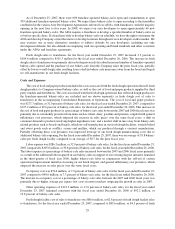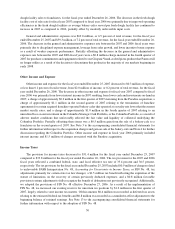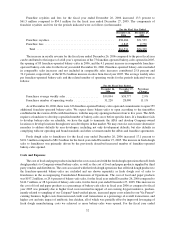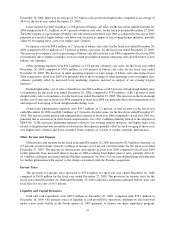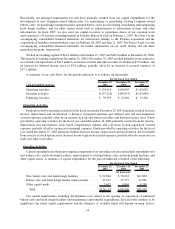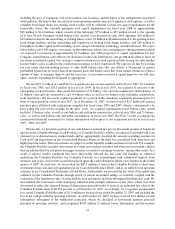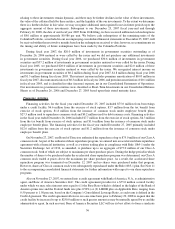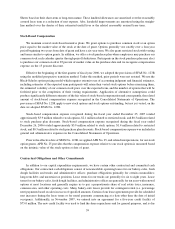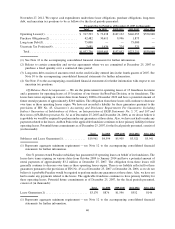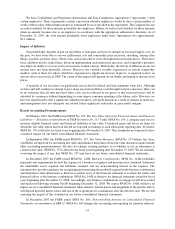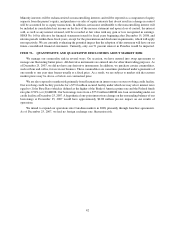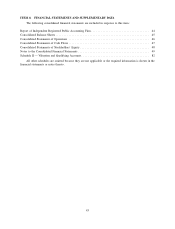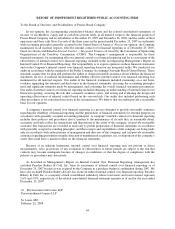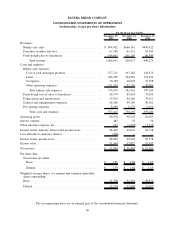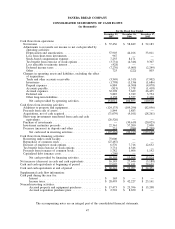Panera Bread 2007 Annual Report Download - page 49
Download and view the complete annual report
Please find page 49 of the 2007 Panera Bread annual report below. You can navigate through the pages in the report by either clicking on the pages listed below, or by using the keyword search tool below to find specific information within the annual report.Sheets based on their short-term or long-term nature. These landlord allowances are amortized over the reasonably
assured lease term as a reduction of rent expense. Also, leasehold improvements are amortized using the straight-
line method over the shorter of their estimated useful lives or the related reasonably assured lease term.
Stock-Based Compensation
We maintain several stock-based incentive plans. We grant options to purchase common stock at an option
price equal to the market value of the stock at the date of grant. Options generally vest ratably over a four-year
period beginning two years from date of grant and have a six-year term. We also grant restricted stock with vesting
and terms similar to option grants. In addition, we offer a stock purchase plan where employees may purchase our
common stock each calendar quarter through payroll deductions. Participants in the stock purchase plan may elect
to purchase our common stock at 85 percent of market value on the purchase date and we recognize compensation
expense on the 15 percent discount.
Effective the beginning of the first quarter of fiscal year 2006, we adopted the provisions of SFAS No. 123R
using the modified prospective transition method. Under this method, prior periods were not restated. We use the
Black-Scholes option pricing model which requires extensive use of accounting judgment and financial estimates,
including estimates of the expected term participants will retain their vested stock options before exercising them,
the estimated volatility of our common stock price over the expected term, and the number of options that will be
forfeited prior to the completion of their vesting requirements. Application of alternative assumptions could
produce significantly different estimates of the fair value of stock-based compensation and consequently, the related
amount of stock-based compensation expense recognized in the Consolidated Statements of Operations. The
provisions of SFAS No. 123R apply to new stock options and stock options outstanding, but not yet vested, on the
date we adopted SFAS No. 123R.
Stock-based compensation expense recognized during the fiscal year ended December 25, 2007 totaled
approximately $3.9 million related to stock options, $2.1 million related to restricted stock, and $0.3 million related
to stock purchase plan discounts. Stock-based compensation expense recognized during the fiscal year ended
December 26, 2006 totaled approximately $5.9 million related to stock options, $1.4 million related to restricted
stock, and $0.3 million related to stock purchase plan discounts. Stock-based compensation expense was included in
general and administrative expenses in the Consolidated Statements of Operations.
Prior to the effective date of SFAS No. 123R, we applied APB No. 25, and related interpretations, for our stock
option grants. APB No. 25 provides that the compensation expense relative to our stock options is measured based
on the intrinsic value of the stock option at date of grant.
Contractual Obligations and Other Commitments
In addition to our capital expenditure requirements, we have certain other contractual and committed cash
obligations. Our contractual cash obligations consist of noncancelable operating leases for our bakery-cafes, fresh
dough facilities and trucks and administrative offices; purchase obligations primarily for certain commodities;
long-term debt; and uncertain tax positions. Lease terms for our trucks are generally for six to eight years. Lease
terms for our bakery-cafes, fresh dough facilities, and administrative offices are generally for ten years with renewal
options at most locations and generally require us to pay a proportionate share of real estate taxes, insurance,
common area, and other operating costs. Many bakery-cafe leases provide for contingent rental (i.e. percentage
rent) payments based on sales in excess of specified amounts. Certain of our lease agreements provide for scheduled
rent increases during the lease terms or for rental payments commencing at a date other than the date of initial
occupancy. Additionally, in November 2007, we entered into an agreement for a five-year credit facility of
$75.0 million. The new credit facility was used to fund the share repurchases and for general purposes, and is due
39


